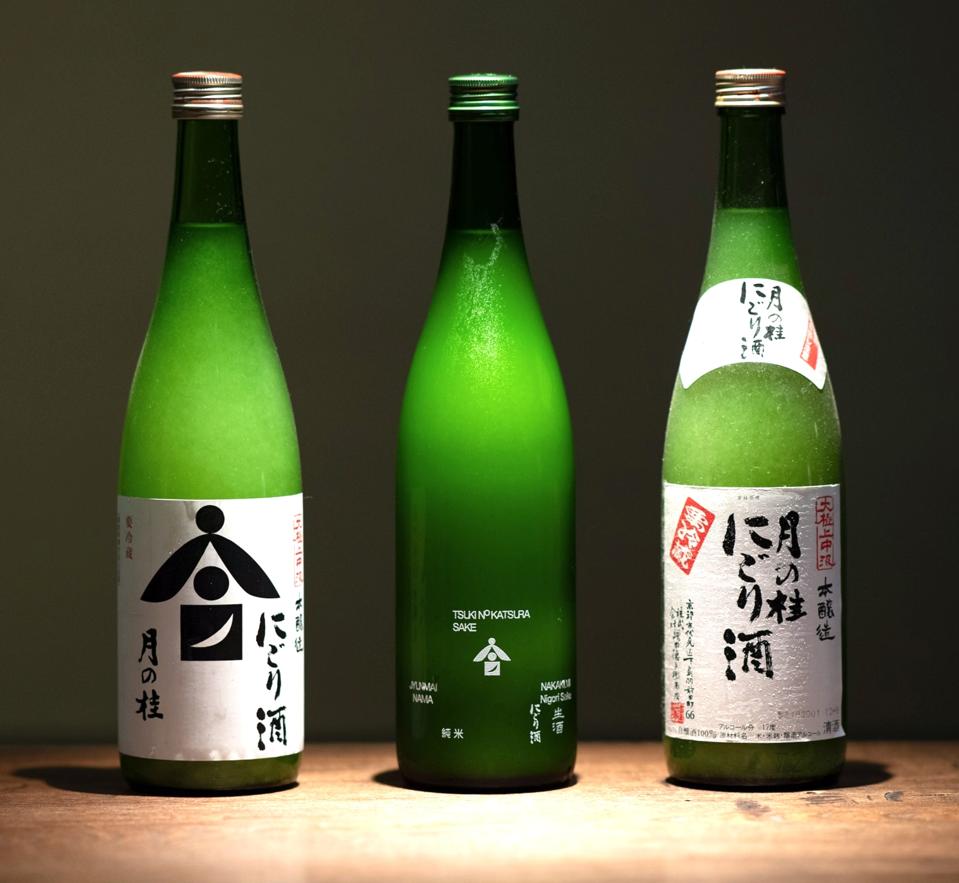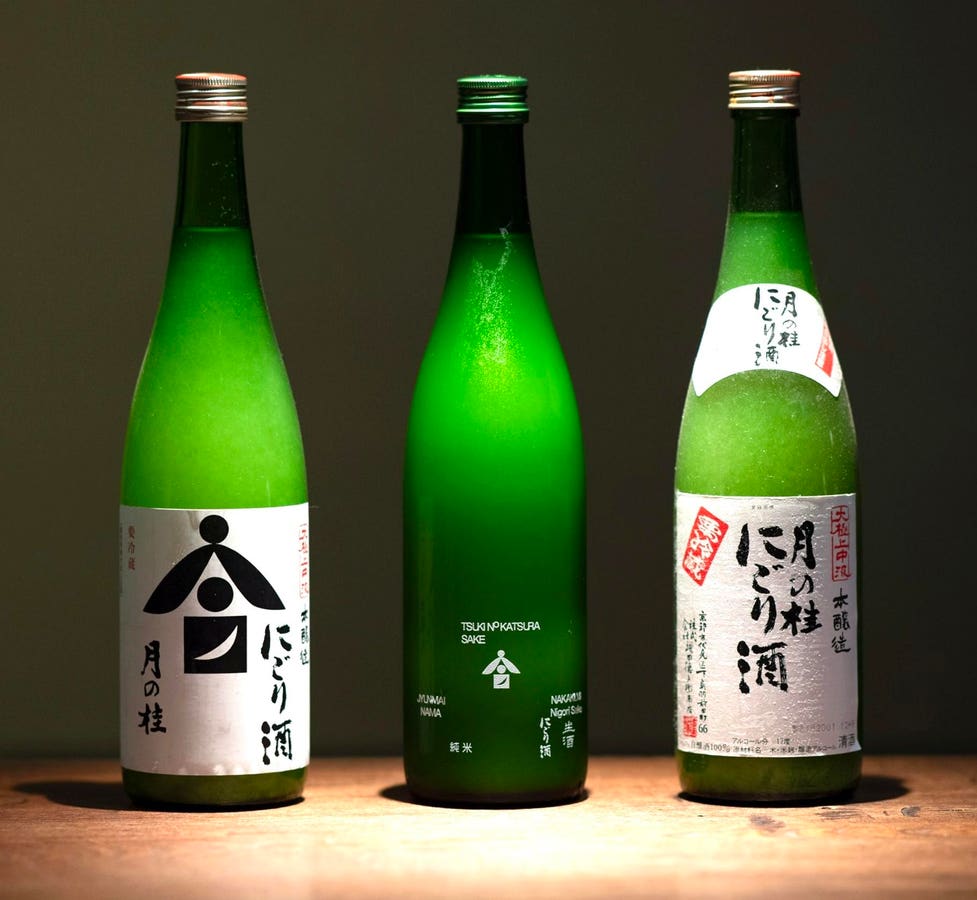
Nigori is great for sake beginners and connoisseurs alike.
Masuda Tokubee Shoten
If you go to a Japanese restaurant in the U.S., Nigori may be the first sake that is recommended for you to try. Indeed, it is a charming, very approachable style of sake.
Nigori means “cloudy” in Japanese. Its snowy, opalescent look comes from the light filtration of the mash in sake production. The remaining sake lees create a delightful, rich mouthfeel with a lingering aftertaste. Also, the residual particles carry pleasant sweetness.
“Americans like Nigori because it is so unique texturally and requires less of a discerning palate to understand, making it a great starter sake,” says Monica Samuels, president of Kome Collective who has over 20 years of experience in the sake industry.
Nigori accounts for approximately 20% of Kome Collective’s sales and the number is growing. “New retailers getting started with sake are viewing Nigori as a great jumping-off point,” she says.
But Nigori is not just an easy sake to try. It has a long, profound history over the last 17 centuries.
The origin of Nigori is Doburoku, a sake that goes through no filtration at all, resulting in a dense, porridge-like texture. Around the 7th century, Doburoku was offered to the gods and over time, people started to develop the filtration techniques. The lightly filtered sake became Nigori.
Nigori had been enjoyed among the public for centuries, whereas the clearer sake with a higher level of filtration was served to the upper classes. Around the 18th century, fully filtered clear sake became more widely available and the popularity of Nigori faded away.
However, in 1964, Nigori celebrated its revival, thanks to Masuda Tokubee Shoten, the 350-year-old sake brewery in Kyoto and the maker of the Tsukinokatsura brand.
“My father decided to reintroduce the charm of the cloudy sake to the market and invented a new method of producing Nigori. He coarsely filtered the mash through a basket and kept the liquid unpasteurized to maintain the rigor of fermentation. Then he let it undergo the second fermentation in a bottle as in the Champagne production,” says Tokubee Masuda, the 14th generation of the brewery.
This sparkling Nigori paved the way to the resurgence of the cloudy sake and now we see various styles of Nigori in the global market.
Tokubee Masuda, 14th generation (left) and his son Junichi Masuda, 15th generation of Masuda Tokubee Shoten.
Masuda Tokubee ShotenWhat Types Of Nigori To Try
Nigori often carries the image of sweet sake, but there are diverse styles of Nigori, from sweet to dry; still, slightly fizzy and sparkling, as listed below.
The two key components of Nigori are the level of filtration and whether the production involves pasteurization or not.
Types By Filtration Levels
Generally speaking, the more coarsely filtered, the richer and sweeter the taste you get from the sake. If you like fully filtered lucid sake, but want to discover the charm of Nigori, start from the bottom of the list below, which has fewer residual particles from the fermentation process. However, Nigori’s pure and bright rice flavor expression can grow on you, because sake is such an ingredient-driven artisanal product.
You will most likely find the umbrella term Nigori on the label of cloudy sake.
The sake looks clearer than regular Nigori and the mouthfeel is lightly velvety.
The cloudiness is even subtler than Usu Nigori. (Note that Sasa Nigori can be synonymous with Usu Nigori, depending on the brand.)
Origarami, or Orizake, is made in the same process as the regular clear sake, but the last step of the production is intentionally skipped: clarification of the liquid after being fully filtered. This type of Nigori lets you enjoy both the clearness of non-Nigori sake and the boost of umami from the floating particles of sake lees.
Types By Pasteurized / Unpasteurized
Pasteurization terminates the fermentation completely to make the sake still. This type of Nigori has a rounded, smooth palate experience.
Nama (Unpasteurized) Nigori/Kassei Nigori
Since the mash was coarsely filtered and unpasteurized, the fermentation continues in the bottle, making the sake naturally fizzy. Many Nigori fans love this liveliness.
The aforementioned sparkling Nigori that Masuda Tokubee Shoten introduced to the market in the 1960s belongs to this type. The Champagne-style sparkling Nigori is festive and elegant with a delicate mouthfeel.
How To Taste Nigori
Chilled Nigori showcases the balance between the sweetness and acidity. You can try Nigori in two ways.
One is to shake the bottle or stir the liquid in the glass to evenly distribute the lees.
The other way is to pour Nigori in the glass and wait for the sediments to settle at the bottom. As you slowly sip it from the clear layer of Nigori on top to the bottom, you can enjoy the gradation of the flavor and mouthfeel.
You can also add other ingredients to Nigori to make a great cocktail, such as Aperol and Matcha. Fruit juice and milk also go very well with Nigori.
Still (pasteurized) Nigori is delicious at a warm temperature, too. The warmed sake is called Kanzake. Typically, somewhere around 86 degrees Fahrenheit (30 degrees Celsius) to 104 degrees Fahrenheit (40 degrees Celsius) works best for Nigori to embrace an elevated fragrance and smoother mouthfeel.
The 14th generation Masuda of Masuda Tokubee Shoten has experimented with various ways to taste Nigori. “One of my favorites is on the rocks, scented with yuzu or lemon peel. I also like pouring Nigori over frozen espresso coffee, which is surprisingly so enjoyable.”
As for food pairings, he loves pairing Nigori with Tonkatsu, a Japanese-style pork cutlet. “Nigori works very well with fried food,” he says.
Kome Collective’s Samuels says, “American flavors tend to be bolder and richer, and Nigori stands up well to those flavors, like barbecue. I really enjoy Nigori with complex spices, like jerk chicken and Indian spice. Also, lacto-fermented foods, such as kimchi, pickles, yogurt and fermented grains like sourdough bread, are popular right now. The tanginess in these foods goes very well with the tart and bright qualities of many Nigori sakes.”
Sweeter nigori can work perfectly with various desserts like chocolate cake and Crème brûlée, just as a dessert wine.
Nigori For Sake Connoisseurs
Dassai, the leading sake producer that is responsible for approximately 15% of the total sake export from Japan, opened its U.S. brewery in New York in 2023. Since then, the company has been exploring innovative strategies to offer the highest quality sake in the global market. The most recent decision it has made is to produce its Nigori sake solely in the U.S. for the global market, including Japan.
The decision to shift the Nigori production entirely to the U.S. makes sense, because 90% of Dassai’s Nigori brewed in Japan has been destined for the U.S. export.
“The key to excellent Nigori is its freshness. The residual particles in Nigori tend to lose their flavor faster than clear sake. By eliminating the lengthy transportation from Japan, we can maintain Nigori’s superb quality,” says Kazuhiro Sakurai, the president of Dassai.
The company waited for the new U.S. brewery to stabilize its operations. “Now, two years after its opening, we are confident of our production capacity to make the highest quality Nigori, just as good as in Japan,” he says.
Dassai has been producing Sparkling Nigori in the U.S. already and it is a success. Sakurai feels the growing potential of Nigori.
“People have been enjoying Nigori for its distinctive color and sweetness. But there are more refined styles of Nigori, like our Daiginjo Sparkling Nigori, available in the market. Considering its food-friendly qualities far beyond Japanese dishes, Nigori can be widely enjoyed among beginners and sake connoisseurs alike all over the world.”
Dassai’s Nigori is now manufactured entirely in the U.S. for the global market, including Japan.
Dassai


AloJapan.com